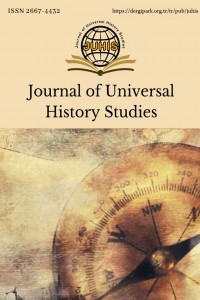Eski Mezopotamya Ticaret Yolları
Güney Mezopotamya’da yaşayan Sumerlerin erken tarihlerde komşu ülkelerle ticarete geçmelerinin sebebi yaşadıkları coğrafyada toprak dışında bir malzemenin olmayışından kaynaklıdır. Sumerler resmi binaları tuğladan, özel evleri ise kerpiçten yaparlardı. Gerek tapınakları süslemek için gerekse silah hammaddesi olarak kalay, bakır, değerli taşlar, altın, gümüş vb. şeyleri komşu ülkelerden tedarik etme yolunu seçtiler. Bu maksatla kara yolundan Elam ülkesine, Anadolu ve Suriye limanlarına, Körfezden su yolu ile Dilmun (Bahreyn), Magan (Umman) ve Meluhha (İndus, günümüz Pakistan)a ulaşarak buralardan bahsettiğimiz değerli madenleri taşıdılar. Böylelikle Sumerler’den itibaren bu bölgenin ticari ilişkileri komşu ülkelerle devam etti. Sumerlerin, Akadların, Asurluların, Babillilerin hammadde ihtiyaçları bazen ticari ilişkilerle bazen de yapılan askeri seferler sonucu yağma ve haraç yoluyla sağlandı diyebiliriz.
Ancient Mesopotamian Trade Routes
The reason why the Sumerians living in Southern Mesopotamia started to trade with neighboring countries in the early years is due to the lack of any material other than the land in the geography they live in. Sumerians used to build official buildings from brick and private houses from adobe. Tin, copper, precious stones, gold, silver, etc. are used both to decorate temples and as weapon raw materials. They chose to procure things from neighboring countries. For this purpose, they reached Elam country, Anatolian and Syrian ports from the land route, Dilmun (Bahrain), Magan (Oman) and Meluhha (Indus, present day Pakistan) by water from the Gulf and carried the precious mines we mentioned here. Thus, the commercial relations of this region continued with neighboring countries since the Sumerians. We can say that it was obtained sometimes through trade relations and sometimes through pillage and extortion as a result of military expeditions. We can say that the raw material needs of the Sumerians, Akkads, Assyrians and Babylonians were met sometimes through trade relations and sometimes through pillage and tribute as a result of military expeditions.
___
- [1] AKT III, E. Bilgiç-C. Günbattı, Ankaraner Kültepetafeln, (FAOS B-3) Stutgart.
- [2] ARM 26, Georges Dossin, Charles-Francois Jean, Archives royales de Mari. Mari ; 1,2. – 1988; 26,1,2
- [3] Bayram, Sabahattin( 1998) “Kültepe’den Kaçakçılıkla İlgili Yeni metinler”, XXXIV. Uluslararası Assyioloji Kongresi Bildirileri, Türk Tarih Kurumu Yayını, Ankara. s. 285-289.
- [4] BIN IV, Clay, A.T, Letters and Transactions from Cappadocia, Babylonian Inscriptions in the Collection of J.B. Nies IV, New Haven 1927.
- [5] Carter , Robert (2013), “Sumerian and Gulf” chapter 30, Edited by, Harriet Crawford, THE SUMERIAN WORLD, New York, 2013, ( 579-599)
- [6] CCT, Cuneiform Texts from Cappadocian Tablets in the British Museum.
- [7] Çeçen , Salih (1997) “Kaniš Kārumu’nun Diğer Kārum ve Wabartumlara KÙ.AN (amutum) ile İlgili Önemli Talimatları”, Belleten, C. LXI, (1997), S. 231, (219-232)
- [8] Dercksen, Jan G. (2004), Old Assyrian Institutions, Leiden .
- [9] Garelli , Paul (1963), Les Assyrians en Cappadoce, Paris.
- [10] Günbattı, Cahit (1998), “Kültepe’den Sargon’a Ait bir Tablet”, III. Uluslararası Hititoloji Kongresi, Çorum 1996, Ankara ( 261-279).
- [11] Heimpel, Wolfrang (2005), Letters to the Kings of Mari, Eisenbrauns .
- [12] Hesse, Khristiana Josephos (2006) “Aspects of Cultural Interactions in the Old Babylonian Period. The Contact Between Mari and Hazor A case Study”, Uppsala Universty, Departman of Archaeology and Ancient History,
- [13] KTS I J. Lewy, Julius, Keilschrifttexte in den Antiken-Museen zu Stanbul, İstanbul 1926.
- [14] KTS II Donbaz,Veysel, Keilschrifttexte in den Antiken-Museen zu Stanbul, Stutgart.
- [15] Koppen, F. Van (1997) , “L'expédition à Tilmun et la révolte des bédouins”, MARI 8, Paris, (417-430)
- [16] Leick, Gwendolyn (2019), Kentin Mucidi Mezopotamya Mitoloji, Arkeoloji ve Tarih (Çev. Ekin Duru) (İstanbul: Say Yayınları, 2019).
- [17] Potts, T.F (1993), “Patterns in third-millenium BC Mesopotamia and İran”, Archaeology ,vol .24, (379-402)
- [18] Potts D. T.( 1990) , The Arabian Gulf in Antiquity, Volume I. Oxford: Clarendon Press.
- [19] Roux , Georges (2005) , “Ur Mezarlığı’nın Büyük Gizemi İçinde Eski Yakındoğu” Sümer’den Kutsal Kitap’a, Cultura (Ankara: Dost Kitabevi,), ( 55-58)
- [20] Şahin, H.Ali, (2004), Anadolu’da Koloniler Devri, Erciyes Üniversitesi Kayseri ve Yöresi Tarih Araştırmaları Merkezi yayını, Kayseri. [21] Thornton, Christopher P, (2013),” Mesopotomia, Meluhha, and Those in between,” , Edited by, Harriet Crawford, chapter 31, THE SUMERIAN WORLD, New York, (600-620)
- [22] Tosun, Mebrure- Kadiye-Yalvaç (1976), Sumer Dili Grameri, Türk Tarih Kurumu Yayını Ankara.
- [23] TCL, Textes Cuneiformes Musee du Louvre , Paris.
- [24] Veenhof, Klaas,R. (1972), Aspects of Old Assyrian Trade and İts Terminology, Leiden.
- [25] Veenhof, Klaas,R. (2010),“The City, its Traders, and its Commercial Network”: Journal of the Economic and Social History of the Orient, 2010, Vol. 53, No. 1/2, Empires and Emporia: The Orient in World Historical Space and Time (39-82)
- Başlangıç: 2018
- Yayıncı: Sabit DOKUYAN
Sayıdaki Diğer Makaleler
1271 (1855) Tarihli Kayseri Kazasına Ait Yoklama Defterinin Tanıtımı ve Tahlili
Almanya’nın Kırım’daki İslam Politikası(1941-1944)
9 Subay Olayı’nda Samet Kuşçu’nun Rolü
Neslihan ALTUNCUOĞLU, Merve DURMUŞ
Kayseri Sancağı Merkez Hapishanesi Dâhilinde Bulunan Dîvân-ı Harp Hapishanesi
Ebulfez Elçibey’in Azerbaycan Özelinde Türk Dünyası Meselelerine Bakışı
Adnan Menderes’in Siyasal Karakteri ve 27 Mayıs
20. Yüzyıl Başlarında Doğu Vilayetlerinin Demografik Yapısı
